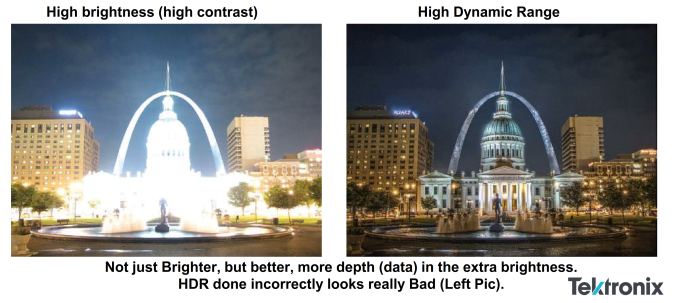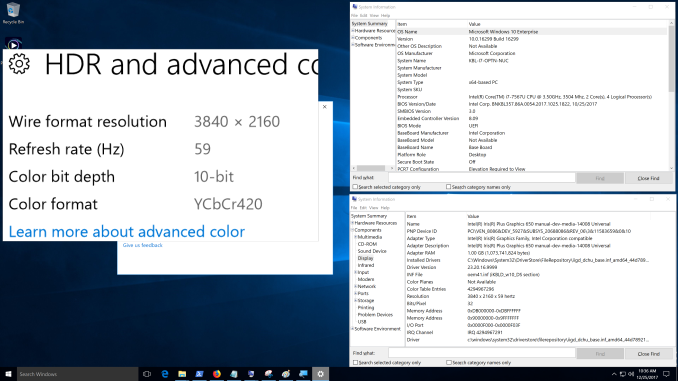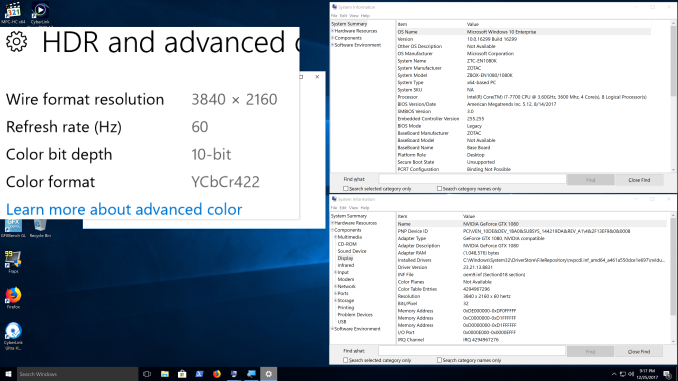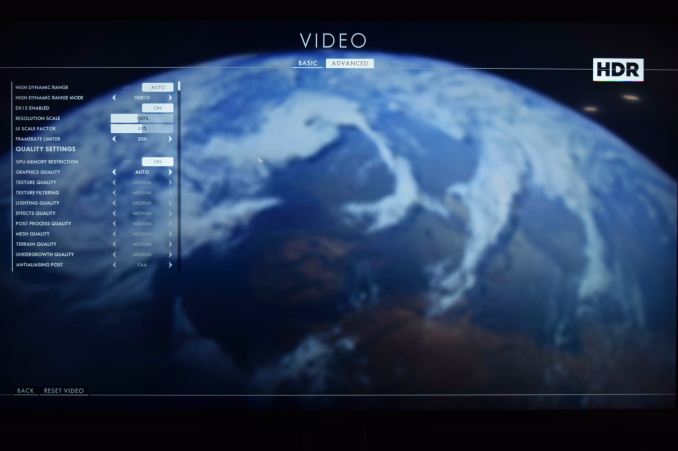A Budget Home Theater & PC Setup: 4K, HDR, UHD Blu-ray, and More
by Ganesh T S on December 26, 2017 8:30 AM ESTHDR Support
High Dynamic Range (HDR) is one of the most impressive features in the recent crop of 4K televisions. In layman's terms, it refers to the ability of a single frame to have wide variation in brightness for different regions. This allows the details in the dimly lit areas of the frame to be seen more clearly. Overall, it delivers a more vivid picture to the viewer. Note that this is quite different from the concept of high contrast.
Picture courtesy: SMPTE HDR Presentation from Steven Holmes of Tektronix
The ability of a display source to transmit HDR frames, as well as that of a display sink to be able to accept and understand them, can be gathered from the HDMI port's specifications. However, being able to accept and understand is only part of the problem. There are many low-cost 'fake HDR' TVs that simply parse the HDR information, but, do not have the ability to translate that to the display.
There are many HDR 'standards', with the base requirement being HDR10. Shifting a display sink into HDR mode involves the source sending some information (metadata) with the characteristics of the video being transported (the mapping of the pixel data to the displayed luminance, light levels in the video stream etc.). If this is static (i.e, done once when the shift to HDR mode occurs), it falls under the HDR10 category. Dolby Vision allows for the metadata to change on a frame-by-frame basis (dynamic). The upcoming HDR10+ standard will also support dynamic metadata. The takeaway is that Dolby Vision certification all but ensures a display with true HDR capabilities.
The TCL 55P607 comes with standard HDR10 and Dolby Vision support. The native Roku apps shift to the appropriate HDR mode based on the content being played back. We will analyze this more in the subsequent sections.
The NVIDIA SHIELD Android TV (SATV) is similar to the native Roku app in the TV with respect to treatment of HDR content. The main issue is that SATV doesn't support Dolby Vision yet, though there is a lot of clamor for it from SATV owners. Videos with HDR10 metadata shift the display to the appropriate HDR mode prior to playback.
PCs encounter additional challenges for HDR implementation. It is just not one company that is responsible for the feature. On one hand, the GPU driver vendors need to support it. On the other hand, the OS itself needs to provide hooks to enable HDR. Finally, the software ecosystem needs to catch up. The Windows 10 Fall Creators Update brought HDR10 capabilities for the Windows desktop into the stable ring. It also allowed streaming of HDR videos from YouTube and Netflix. Microsoft is continuing to fine-tune the HDR capabilities built into Windows 10.
Intel, along with CyberLink, had decided not to wait for Microsoft to deliver HDR on PCs. PowerDVD 17 was the first software Blu-ray player, and it only made sense for them to support HDR playback for applicable titles. The Intel / CyberLink solution for HDR when playing back certain Blu-rays in full-screen exclusive mode is orthogonal to Microsoft's HDR support.
The Windows 10 Fall Creators Update enabled desktop HDR and HDR video streaming on all the three test PCs described earlier.
HDR and Advanced Color Settings - Intel NUC7i7BNHX1 with Desktop HDR Enabled
The KBL-U platforms drove the display at YCbCr 4:2:0 10-bit, while the NVIDIA GTX 1080 drove the HDR output with higher quality (YCbCr 4:2:2 10-bit). For a good desktop experience, 4:4:4 is preferable.
HDR and Advanced Color Settings - Zotac ZBOX MAGNUS EN1080K with Desktop HDR Enabled
Gaming is not a focus in our HTPC reviews, but, we must give credit to NVIDIA for supporting Dolby Vision in their Pascal GPUs. Certain gaming titles such as Battlefield 1 support both HDR varieties (HDR10 and Dolby Vision), and the Zotac EN1080K is able to deliver it in a HTPC environment, thanks to its small form factor and relatively silent liquid cooling.
Battlefield 1 HDR Output from the Zotac EN1080K
Battlefield 1 Dolby Vision Output from the Zotac EN1080K
Unfortunately, Pascal's Dolby Vision support is available only in certain games, and is not applicable to streaming services like Netflix.
Microsoft's current approach to HDR with a desktop HDR mode is currently not efficiently implemented. For example, the desktop in the Zotac ZBOX MAGNUS EN1080K idles at 34.5W. With the HDR mode enabled, this jumps to 39.5W. In the KBL-U systems the penalty is of the order of 0.8W - 1W.















191 Comments
View All Comments
ganeshts - Tuesday, December 26, 2017 - link
I would love to get a rundown of the budget for that PR server backend. Still too limited IMO and not enough flexibility.Aspernari - Tuesday, December 26, 2017 - link
"On a budget", then recommends and links a receiver over twice the cost of the TV!Come on. Seriously.
Aspernari - Tuesday, December 26, 2017 - link
Replying to myself to further comment: His actual recommendation, the Denon AVRS730H is merely JUST AS EXPENSIVE as the TV.And then there's no actual speakers, or mention of speakers on the entire AVR page... So why are we getting a receiver?
At the price of the receiver alone, you can start getting into entry level Atmos-enabled soundbars.
ganeshts - Tuesday, December 26, 2017 - link
How is $349 / $429 as expensive as a $700 TV? Maybe you are seeing some other numbers?ddrіver - Tuesday, December 26, 2017 - link
Ganesh, are you actively trying to not understand the point multiple people are making? DO NOT PUT "BUDGET"-ANYTHING IN THE TITLE. Especially if you're going to use a $2000 HTPC with a GTX1080, or a $1000 receiver (https://www.amazon.com/dp/B072Z9ZGSZ ). Did I already say it? This is not budget!Do you get your Christmas bonus for clicks? I clicked because I'm looking for a receiver recommendation on a budget and expected some good but cheap options. And I find you're actually using a $1000 model and just mentioning another almost $500 model (https://www.amazon.com/Denon-AVRS730H-Receiver-wir... ) once without detailing much on alternatives or what similar models I could go for. You went on to talk about the $1000 model for the rest of the receiver section.
Aspernari - Tuesday, December 26, 2017 - link
Whoops, I was thinking about the S405. Sorry, the receiver is only nearly as expensive as the TV when the TV is on a good sale. Now, let's get back to the absurdity of this article.This article lacks direction and focus. It misses the mark for both its stated purpose, and as any sort of reasonable guide or reference.
- Assume the reader is recycling speakers, but not any other components - Going all the way down to HDMI cables.
- Clearly a sponsored deal with Denon. It's disclosed but still awful since no other receiver is mentioned, alternatives like soundbars (again, low end Atmos is available for less than the recommended receiver) are never mentioned, and anyone looking for help unpacking the current audio tech is left on their own.
- $2000 HTPC, even as a joke option, is more than the entire rest of the recommended kit combined.
- Recommending all sorts of hardware that doesn't support features that should have been seen as requirements (Tegra and the $2000 HTPC failing to provide full HDR support, etc).
- Recommending a $200 Android device in an article about budget setups featuring a Roku TV.
- $200 more in Bluray playback equipment to the HTPCs, but no consideration for UHD bluray players or the Xbox One S - The recommendation is to deal with the minefield of compatibility issues rather than spend the same sum on a standalone solution that doesn't suffer from those problems - and plays games!
- I'm going to harp on the Denon sponsorship and the clear bias there again. There are two products named in the article subsections. The TV, and the receiver. And it's not even the recommended receiver! No other single product gets an entire page to itself. The section about the receiver is even longer than the TV. There's no info provided about the S730H, not even basic specs. Congrats on your free $1000 receiver, but it doesn't belong in a budget article.
I get that you wrote this as a "this is what I did" article, not a comprehensive guide, but come on. No alternatives suggested for the Denon is... Really galling.
we - Tuesday, December 26, 2017 - link
Apparently Ultra HD Blue-ray video and sound quality from the Xbox One S is somewhat disappointing.https://www.whathifi.com/news/no-xbox-one-s-isnt-v...
Aspernari - Tuesday, December 26, 2017 - link
There've been some patches since that article was published which, as I understand it, addressed most of the quality issues.I have an X, and have no complaints - but I also don't have another UHD disk player to compare against.
Aikouka - Wednesday, December 27, 2017 - link
I've mentioned this before, but the Xbox One's greatest flaw is that it's too noisy. Disc noise pushed me away from using the player after playing only a single movie (Sicario). I also ran into problems with the disc freezing in random spots, but not always in the same spot. (Do note that other players had no problems with the disc at all.) If you want a basic UHD player, I'd probably go with the Sony X800. I've had the best luck with mine so far with only a few hiccups in the beginning. I did replace it simply because I wanted a unit with Dolby Vision, which the only decent (but not cheap) option there was the Oppo 203.Galid - Wednesday, December 27, 2017 - link
There must be a lot of kids in here, this is not SUPER budget but it sure is budget in my mind. My home theater setup without the PC is worth 6k$ and it is considered cheap by many standards. The best budget and worthy contender for around 600$ would be the Onkyo NR727. I myself would not consider anything below but that's only 200$ cheaper. ONE of my speakers costs freaking 400$ and I'm really considered on the OK/cheap side. Do you guys ever go out in stores, you know, not those internet websites where you click and wait, ACTUAL audio video stores? WAW you guys need to see the light outside, it's made by the SUN! WAW!!! Any respectable audio video store will have AVR + speakers setups from 1k to 50k$++, so I would consider 1 to 5k pretty cheap.Wanna go ultra budget, buy used and freaking leave this website alone. What do you want, website full of used audio video pieces of equipment just leave this place. Sure this article could be better but it sure look budget friendly to me and I'm FAR from being a rich guy.
When I see people complaining about a 800$ receiver, I cannot help but wonder who's reading these articles. You work for mcdonalds 24h a week? Don't look at buying a home theater, get a BETTER JOB then come back ffs.